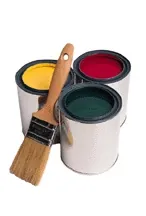We have complied these painting tips to make painting in your home an easier, more enjoyable experience.

- Keeping a paint can from getting too messy can be the hardest part of the job. Here’s a tip — slide a rubber band over the open can so it stretches top to bottom across the open can. Then, when you pull the brush out of the paint wipe the bottom against the rubber band each time to avoid unnecessary drips. This works especially well on smaller cans without handles. The rubber band keeps the entire can neater and it makes the lid a lot easier to put on when the job is complete.
- When painting interior walls, you’ll eliminate a lot of backbreaking labor by mounting your roller on an extension pole. You won’t have to bend over to load the roller, and you won’t have to spend as much time on a ladder. And by standing away from the wall as you work, it is easier to see any missed areas.
- Before dipping a brush in paint, dip it into water (for water based paints) or paint thinner (for oil-based paints) and spin out the excess. This wets the bristles in the ferrule (the metal base) and prevents paint from building up in there, which makes cleanup easier and extends the brush’s life.
- Hanging light and fan fixtures can be a nuisance when painting a ceiling. A simple solution to save the fixture from paint splatter without taking it down is to slip a large plastic trash bag over the light and seal it closed with a twist tie. Do the same to seal out dust and dirt during demolition and renovation projects. Just be sure to keep the light off while it’s sealed so heat from the bulbs won’t melt or ignite the plastic bag.
- Prolonged exposure to the weather turns wood gray, and weathered wood makes a poor base for new paint. That’s because the sunlight degrades the lignin that holds wood cells together. Sand down to fresh wood, then prime the surface before painting.
- Some paint manufacturers offer kitchen and bathroom collections specially formulated for steamy rooms. Designed to resist moisture and inhibit mildew growth, they also give a wipe-clean finish.
- Masking tape is one of the least expensive but most useful painting tools you’ll find. But buy only the good stuff. Standard masking tape is often too sticky, and leaves behind a residue that can interfere with a painted finish. It’s also thicker than genuine painter’s masking tape, making it more likely to cause drips.
- When buying paint, always buy more than you need. The extra can be used for touch-ups, plus it’s a lot safer than running out and having to match what was already bought.
- To prevent a skin from forming on your paint while it’s in storage, cut a circle of wax paper or aluminum foil and place it directly on the surface of the paint inside the can. This will protect the paint and keep it fresh.
- To get extra life from any outdoor paint job, coat the bare wood with water repellent preservative before priming or painting it. Use only a repellent that is clearly labeled as paintable; some contain substances that will prevent paint from bonding properly.
- Choose a family-friendly paint type such as a satin or semigloss finish. A flat finish is not as family- friendly because it doesn’t wipe clean as easily. Stick to high gloss for door frames where little hands touch frequently.
- Use the “W” technique when painting walls. Start in a corner of the wall and roll on a 3' x 3' W pattern, then fill it in without lifting the roller. Always paint one wall at a time and paint trim last.
- When you’re done painting for the day, and know you need to continue on the next day, scrape off the excess paint, stick your brush in a resealable plastic bag, press the air out and seal. This keeps the brush from drying out even if you don’t get back to the job for a couple of days. The same trick works for rollers too, sealing the bag with a twist-tie around the handle. As soon as you’re finished with your project, give your brushes a thorough cleaning to ensure they will last a long time.
- Painting over mildew doesn’t mean it’s gone — the sturdy spores are quite capable of growing right through paint film. Shady spots outdoors are particularly susceptible to this fungal pest, which will root itself into a porous surface once the right temperature and enough moisture is available. To kill mildew, wash it with a mixture of 1 part household bleach to 3 parts water. Then rinse the area thoroughly.
Here are some related articles:
Save this article to:
back to top